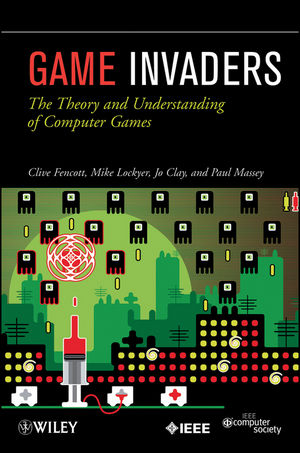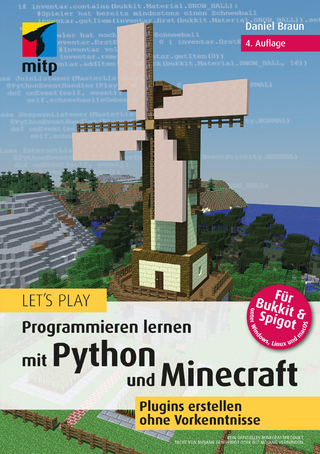
Game Invaders
John Wiley & Sons Inc (Verlag)
978-0-470-59718-7 (ISBN)
- Lieferbar (Termin unbekannt)
- Versandkostenfrei innerhalb Deutschlands
- Auch auf Rechnung
- Verfügbarkeit in der Filiale vor Ort prüfen
- Artikel merken
Presenting a holistic and thoroughly practical investigation of the true nature of computer games that arms readers with a small yet powerful set of theories for developing unique approaches to understanding games. Game Invaders fully integrates genre theory, new media aesthetics, perceptual opportunities, and semiotics into a practical DIY toolkit for games analysis—offering detailed guidance for how to conduct in-depth critiques of game content and gameplay.
Featuring an informal and witty writing style, the book devotes a number of chapters to specific games from all eras, clearly demonstrating the practical application of the theories to modern, large-scale computer games. Readers will find:
• Suggestions on how to apply the DIY package to major issues central to understanding computer games and their design • Coverage of the semiotics of video games, laying the foundation for such topics as the role of agency and virtual storytelling • Tasks and solutions for readers wishing to practice techniques introduced in the book • A companion website featuring access to an app that enables the reader to conduct their own activity profiling of games
An important resource for those wishing to dig deeper into the games they design, Game Invaders gives game designers the skills they need to stand out from the crowd. It is also a valuable guide for anyone wishing to learn more about computer games, virtual reality, and new media.
CLIVE FENCOTT, PhD, is a freelance writer and researcher in new media. For many years, he taught and researched the theory of computer games at Teesside University in the UK. He also worked in the games industry. Dr. Fencott has authored over fifty publications, including the successful textbook Formal Methods for Concurrency. MIKE LOCKYER, BSc, PhD, is a Professor of Web Services at Teesside University, where he has taught for over twenty-five years. He has published over thirty journal papers, successfully supervised more than ten PhDs, and is currently involved with developments in web services and rich client applications. JO CLAY completed a multimedia master's degree at Teesside University, under the supervision of Clive Fencott, before joining the games analysis team. As a gamer herself and apprentice semiotician, Jo assisted in the development of the Game Invaders method for application in computer software. PAUL MASSEY, CEng, MBCS, CITP, is a senior lecturer in computing at Teesside University, where he teaches and consults on databases. Paul believes databases are central to most IT systems and applies techniques (such as data mining) to a range of disciplines (such as games analysis and decision support).
Preface ix
Abbreviations xi
Part I Why Do People Play Games?
1. You Are the One 3
Tools to Think With 5
Getting Started 8
Summary 12
2. Genre 13
What Are Genres? 14
What Are Genres For? 16
Genre Maps 18
Computer Game Genres 19
A Theory of Computer Game Genres 21
Summary 25
Further Reading and Tasks 26
3. Activity 29
The Story of Activity Groups 29
An Overview of Activity Profiles 33
Three Driving Games 35
Calculating Genres 38
Summary 43
Tasks 44
4. Pleasure 45
Aesthetics and Computer Games 47
Spacewar 51
Zork 52
Pac-Man 56
Comparative Aesthetics 57
Summary 59
Tasks 60
5. Two Rail-Shooters 61
Star Fox and Rez 61
Activity Profiling and Genre Theory 63
Applying Aesthetic Theory 65
The Method of Game Analysis 67
Tetsuya Mizuguchi, Rez, and Beyond 67
Summary 69
Further Reading and Tasks 70
6. Why Don’t People Play Games 71
What Do We Mean by Games? 72
Resident Evil 73
Why Not Ask the Players? 75
Emotional Models of Play 76
Player Types 79
Demographic Research 81
Why Don’t People Play Games? 82
Conclusions 83
Part II What Is a Game?
7. Just an Ordinary Day 87
The Glass Vial 89
Unrealisms 90
Perceptual Opportunities 91
Sureties 92
Surprises 93
Attractors 93
Connectors 95
Rewards 97
Getting It All Together in SinCity 99
Perceptual Mapping in SinCity 100
AS-OceanFloor 103
Summary 108
Further Reading and Tasks 109
8. Big Bad Streets 111
Driver School 111
Sureties 113
Surprises 114
Driver and SinCity Comparisons 119
Summary 122
Further Reading and Tasks 123
9. Time to Visit Yokosuka 125
Shenmue 125
Genre and Activity Profile 126
Aesthetics 128
Shenmue POs 129
PSAS and Cut Scenes 131
Interactive Storytelling? 133
And On With General Aesthetics 134
Summary 135
Further Reading and Tasks 137
10. Meaning What? 139
Semiotics and Signs 140
Pac-Man’s Signs 143
Icons, Indexes, and Symbols 144
Denotation, Connotation, and Myth 146
Syntagms and Paradigms 148
Codes 151
Making Up Pac-Man 154
Filling Gaps 155
Summary 159
Further Reading and Tasks 161
11. All Work and Play 163
The Work of Meaning 164
Signs of Interaction 167
The Mechanics of Interaction 170
The Inside-Out Code 176
Where Is the Player? 178
Summary 180
Further Reading and Tasks 181
12. Big Game Hunting 183
Semiosphere 183
The Code of Interaction 185
The Myth of Interaction 189
What Is a Game? 191
How Do You Get Out of Here? 192
Big Game Hunting 194
Glossary 197
List of Games 203
Bibliography 205
Index 207
| Zusatzinfo | Photos: 20 B&W, 70 Color; Drawings: 20 B&W, 0 Color; Tables: 30 B&W, 0 Color |
|---|---|
| Verlagsort | New York |
| Sprache | englisch |
| Maße | 156 x 235 mm |
| Gewicht | 422 g |
| Themenwelt | Informatik ► Software Entwicklung ► Spieleprogrammierung |
| Schlagworte | Computerspiel • Softwareentwicklung |
| ISBN-10 | 0-470-59718-6 / 0470597186 |
| ISBN-13 | 978-0-470-59718-7 / 9780470597187 |
| Zustand | Neuware |
| Informationen gemäß Produktsicherheitsverordnung (GPSR) | |
| Haben Sie eine Frage zum Produkt? |
aus dem Bereich


